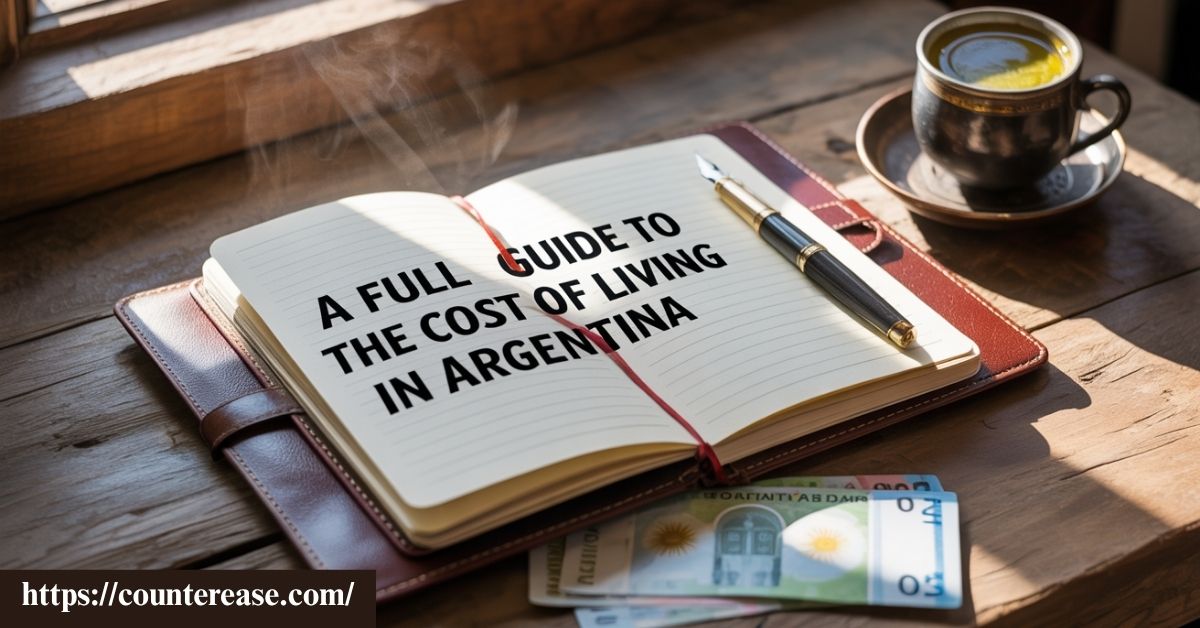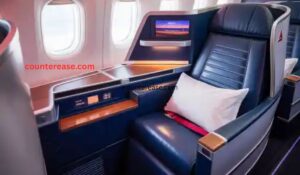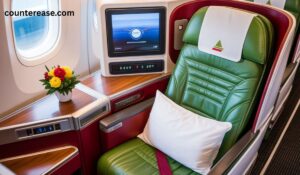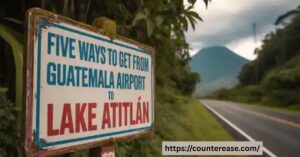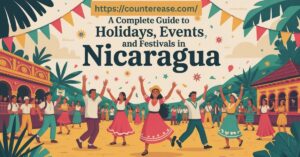The cost-of-living-argentina-guide is a complete resource that outlines the average expenses of living in Argentina, covering everything from housing and transportation to dining, entertainment, and daily essentials. Its cost of living argentina guide helps you understand how much money is needed to maintain a comfortable lifestyle, whether you’re a traveler, digital nomad, or planning a long-term stay. This cost of living argentina guide provides realistic figures so you can plan your budget with confidence.
Argentina is a rare blend of affordability and beauty. Imagine sipping Malbec in Mendoza for a fraction of European wine prices or enjoying a gourmet steak dinner in Buenos Aires that costs less than a casual meal back home. With vibrant cities, breathtaking landscapes, and a favorable currency exchange rate, living here feels like luxury without the hefty bill.
In this cost-of-living-argentina-guide, you’ll find detailed insights into different regions, revealing how costs vary between bustling urban hubs and tranquil rural towns. From monthly rent in Palermo to grocery prices in Córdoba, this guide paints a clear picture of everyday expenses. Whether you’re chasing cultural experiences, scenic escapes, or a budget-friendly lifestyle, Argentina offers an irresistible mix of value and charm.
The Real Cost of Living in Argentina
Argentina beckons with a tantalizing promise. Your dollars stretch further here. Your stable foreign currency transforms into Argentine pesos at rates that make luxury affordable. The cost of living in Argentina remains a fraction of what you’d pay in North America or Europe.
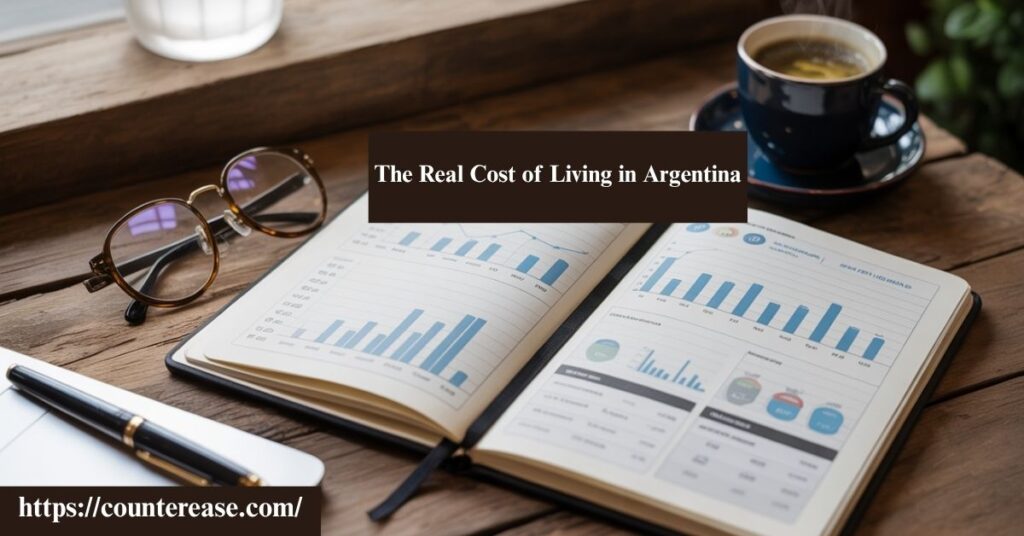
But here’s the catch. Argentina’s economy shifts like tango dancers on a Saturday night. Inflation soars. Exchange rates fluctuate wildly. What costs 100 pesos today might cost 150 tomorrow.
This guide cuts through the confusion. We’ll explore real numbers from Buenos Aires to Patagonia. You’ll discover how to live well without overspending while experiencing Argentina’s rich culture, stunning landscapes, and world-class food.
Whether you’re planning solo backpacking adventures or seeking a permanent home base, you’re in the right place. Let’s dive into the financial reality of making Argentina your next destination.
The Big Picture: Argentina’s Economic Reality
Argentina’s economy resembles a roller coaster that never stops. Understanding the costs and planning wisely becomes crucial when inflation hovers around 100% annually.
The country operates multiple exchange rates. The official rate might show 350 pesos per dollar. Meanwhile, the “blue dollar” rate hits 700 pesos. This parallel market exists because Argentines can’t freely buy dollars at banks.
See Also: Review: Chelsea Lounge; American Airlines/British Airways First Class Flagship Lounge New York (JFK)
Here’s what this means for you:
- Your foreign income provides massive purchasing power
- Prices change rapidly, sometimes weekly
- Regional variations create significant cost differences
- Timing your arrival affects your budget dramatically
Regional Cost Variations
| Region | Cost Level | Monthly Budget Range |
|---|---|---|
| Buenos Aires | Highest | $1,200-$3,500 |
| Córdoba | Medium | $800-$2,200 |
| Mendoza | Medium-High | $900-$2,800 |
| Rosario | Medium | $750-$2,000 |
| Bariloche | High (Tourist Season) | $1,000-$3,200 |
| Salta | Low-Medium | $650-$1,800 |
The economic volatility creates opportunities. Smart expats time major purchases during peso devaluations. They stock up on imported goods before prices spike.
Housing: Your Biggest Monthly Expense
Housing dominates expat budgets in Argentina. Buenos Aires commands premium prices while smaller cities offer incredible value.
Buenos Aires Neighborhood Breakdown
Palermo attracts young professionals and digital nomads. Expect to pay $600-$1,500 monthly for a one-bedroom apartment. The area buzzes with vibrant streets, trendy restaurants, and excellent nightlife.
San Telmo offers authentic porteño culture at lower prices. One-bedroom apartments range from $400-$900. You’ll walk on cobblestone streets where tango originated.
Villa Crick provides middle-class comfort. Families favor this quiet neighborhood. Rent runs $350-$700 for spacious apartments.
Rental Market Strategies
Temporary rentals cost significantly more than long-term contracts. Airbnb charges $40-$100 daily in Buenos Aires. Long-term furnished apartments drop to $500-$1,200 monthly.
Local rental requirements include:
- Security deposit (1-2 months)
- Real estate commission (4.17% of annual rent)
- Guarantor with Buenos Aires property (for unfurnished)
- Income verification documents
Utilities: The Hidden Costs
Argentina subsidizes utilities heavily. Electricity bills rarely exceed $20-$40 monthly, even with air conditioning. Gas heating costs $15-$30. Water adds another $10-$20.
Internet proves more expensive. Reliable 100 Mbps connections cost $25-$45 monthly. Cell phone plans with unlimited data run $15-$30.
Streaming services offer regional pricing:
- Netflix: $4-$6/month
- Spotify: $2-$4/month
- Amazon Prime: $3-$5/month
Food: From Empanadas to Asado
Argentina’s food culture revolves around social dining. Massive portions mean doggie bags become normal. The world-class food scene spans from street empanadas to Michelin-worthy steakhouses.
Grocery Shopping Strategies
Local supermarket chains like Coto, Jumbo, and Disco offer competitive prices. Fresh markets (ferias) provide seasonal produce at unbeatable rates.
Monthly grocery costs by lifestyle:
| Lifestyle | Monthly Grocery Budget |
|---|---|
| Basic Local Diet | $150-$250 |
| Mixed Local/International | $250-$400 |
| International Brands Focus | $400-$600 |
Imported products carry heavy taxes. A jar of Nutella costs $8-$12. Local dulce de leche costs $2-$3. Smart shoppers adapt to local alternatives.
Dining Out Culture
Parrillas (steakhouses) serve enormous portions perfect for sharing. Expect $15-$25 per person for quality asado with wine. Neighborhood pizzerias charge $8-$15 for pizzas that feed two people.
Buenos Aires restaurant pricing:
- Empanadas: $0.50-$1.50 each
- Pizza slice: $2-$4
- Milanesa dinner: $8-$15
- Fine dining tasting menu: $50-$120
- Craft beer: $3-$6
- House wine glass: $2-$4
Coffee culture thrives in Buenos Aires. Café cortado costs $1-$2. Many cafés offer free WiFi and welcome laptop users for hours.
Transportation: Getting Around Without Breaking the Bank
Public transportation in Argentina offers incredible value. Buenos Aires operates one of the world’s most affordable transit systems.
Public Transport Systems
The subway (Subte) costs about $0.25 per ride. Buses charge similar rates with routes covering the entire metropolitan area. Monthly unlimited cards cost around $15-$20.
Transportation costs comparison:
| Method | Cost Range |
|---|---|
| Subte/Bus Single Ride | $0.20-$0.30 |
| Monthly Transit Pass | $15-$25 |
| Taxi (5km ride) | $3-$6 |
| Uber (5km ride) | $2-$5 |
| Car Rental Daily | $25-$45 |
Car Ownership Considerations
Cars cost significantly more than in the US or Europe. A basic sedan starts around $20,000. Fuel prices hover near $1.20-$1.50 per liter.
Insurance, registration, and maintenance add substantial ongoing costs. Most expats rely on public transport and occasional rideshares.
Domestic flights provide reasonable long-distance travel. Buenos Aires to Bariloche flights cost $100-$200. Book early for better deals.
Healthcare: Quality Care at Fraction of US Costs
Argentina’s healthcare system delivers excellent value. Public hospitals provide free emergency care to everyone. Private insurance offers premium service at affordable rates.
Healthcare Cost Breakdown
Private health insurance plans cost $50-$150 monthly for comprehensive coverage. These plans include dental, vision, and prescription benefits.
Common medical procedure costs:
| Procedure | Approximate Cost |
|---|---|
| General Doctor Visit | $15-$30 |
| Specialist Consultation | $25-$50 |
| Dental Cleaning | $20-$35 |
| Basic Blood Work | $25-$40 |
| Emergency Room Visit | $50-$100 |
| MRI Scan | $200-$350 |
Prescription medications cost significantly less than US prices. Generic drugs offer additional savings. Many medications available over-the-counter require prescriptions elsewhere.
See Also: The Ultimate Packing List for a 7 Day Trip
Finding Quality Healthcare
Private clinics in Buenos Aires rival international standards. Hospital Italiano, Hospital Alemán, and Sanatorio Trinidad maintain excellent reputations.
Smaller cities offer quality care at even lower prices. Córdoba and Rosario feature medical schools producing skilled practitioners.
Lifestyle and Entertainment
Argentina offers an incredible lifestyle with abundant cultural activities. Theater tickets cost $10-$25. World-class museums charge $2-$5 admission.

Education Options
International schools in Buenos Aires charge $300-$800 monthly tuition. Local private schools cost $100-$300. Public universities offer free education, even for foreigners.
Spanish language courses range from $150-$400 monthly for group classes. Private tutors charge $15-$25 per hour.
Recreation and Culture
Gym memberships cost $25-$50 monthly. Boutique fitness classes run $8-$15 per session. Many parks offer free outdoor exercise equipment.
Entertainment pricing:
- Movie tickets: $4-$8
- Theater shows: $10-$25
- Football match tickets: $15-$50
- Nightclub entry: $10-$20
- Wine tasting tours: $30-$60
Argentina’s wine regions provide incredible experiences. Mendoza winery tours cost $40-$80 including transportation and tastings.
Working in Argentina: Income vs. Expenses
Remote workers with foreign income enjoy significant advantages. Your dollars provide 2-3 times the local purchasing power.
Digital Nomad Considerations
Argentina welcomes digital nomads working for foreign companies. Tourist visas allow 90-day stays with possible extensions.
Visa options for longer stays:
- Tourist visa: 90 days (extendable)
- Temporary resident visa: 1 year (renewable)
- Student visa: Duration of studies
- Investment visa: 2 years (with $1,500+ monthly income proof)
Banking Challenges and Solutions
Argentine banks restrict foreign account opening. Many expats use international banks like HSBC or Santander with global presence.
Western Union and similar services provide money transfer options. Crypto adoption grows among tech-savvy expats seeking financial flexibility.
City-by-City Breakdown: Where Your Money Goes Furthest
Buenos Aires: The Expensive Capital
Buenos Aires offers unmatched cultural richness but commands premium prices. A comfortable expat lifestyle requires $1,500-$2,500 monthly.
Sample monthly budget:
- Rent (1BR furnished): $800
- Utilities/Internet: $100
- Groceries: $300
- Dining out: $400
- Transportation: $50
- Entertainment: $200
- Miscellaneous: $150
- Total: $2,000
Córdoba: Student City Savings
Córdoba provides excellent value with vibrant university culture. Monthly expenses drop 30-40% compared to Buenos Aires.
The city offers rich culture through music festivals, art galleries, and historic architecture. Students and young professionals create an energetic atmosphere.
Mendoza: Wine Country Living
Mendoza combines natural beauty with affordable living. The Andes mountains provide stunning landscapes while wineries offer world-class tastings.
Tourist seasons inflate prices temporarily. Off-season living costs resemble smaller Argentine cities with added natural attractions.
Bariloche: Patagonian Paradise Pricing
Bariloche attracts outdoor enthusiasts and luxury tourists. Prices fluctuate dramatically between seasons.
Summer (December-March) brings crowds and premium pricing. Winter offers skiing but maintains elevated costs. Shoulder seasons provide the best value.
Money-Saving Strategies That Actually Work
Successful expats develop local financial habits. They shop at neighborhood markets, avoid touristy areas, and time purchases strategically.
Exchange Rate Optimization
Monitor blue dollar rates through reliable sources. Some expats use legal casa de cambio (exchange houses) offering better rates than banks.
Never engage in illegal currency exchange. Stick to legitimate businesses and documented transactions.
Shopping Smart
Local brands often match international quality at lower prices. Arcor chocolates rival imported brands. Local wines cost $3-$8 for restaurant-quality bottles.
Money-saving shopping tips:
- Shop during weekly sales (often Wednesdays)
- Buy seasonal produce at ferias
- Use supermarket loyalty programs
- Stock up during peso devaluations
- Choose local brands over imports
Avoiding Tourist Traps
Tourist areas charge 50-100% premiums. Puerto Madero restaurants cost double compared to neighborhood parrillas serving identical steaks.
Learn basic Spanish phrases. Vendors adjust prices based on perceived tourist status. Practical tips include dressing like locals and researching standard prices.
See Also: A Guide to Eating and Street Food in Guatemala
Hidden Costs Nobody Warns You About
Argentina’s bureaucracy creates unexpected expenses. Visa renewals require document apostilles costing $50-$100. Legal translations add another $30-$50 per document.
Professional Service Fees
Accountants charge $100-$200 monthly for tax compliance. Immigration lawyers cost $500-$1,500 for residency applications. These services become essential for longer stays.
Import Duties and Restrictions
Bringing electronics or household goods incurs heavy duties. Laptops face 50% taxes. Used items require complex customs procedures.
Emergency fund recommendations: Maintain 3-6 months expenses in accessible foreign currency. Argentina’s economic volatility demands financial buffers.
Sample Monthly Budgets: Three Lifestyle Scenarios
Budget Backpacker ($800-1,200/month)
This lifestyle suits young travelers and gap-year students. Shared housing and local food keep costs minimal.

Monthly breakdown:
- Shared room: $200-$300
- Local groceries: $150-$200
- Street food/cheap restaurants: $200-$300
- Public transport: $20-$30
- Entertainment: $100-$150
- Miscellaneous: $130-$220
Comfortable Expat ($1,500-2,500/month)
Mid-career professionals and retirees enjoy private apartments with modern amenities. Mixed dining includes restaurants and home cooking.
Monthly breakdown:
- Private 1BR apartment: $600-$900
- Groceries/dining mix: $400-$600
- Utilities/internet: $80-$120
- Transportation (mix): $60-$100
- Healthcare: $50-$100
- Entertainment: $200-$300
- Miscellaneous: $150-$380
Luxury Lifestyle ($3,000+/month)
High-income earners enjoy premium housing, fine dining, and regular travel. This budget provides Developed countries amenities at developing-world prices.
Monthly breakdown:
- Luxury apartment: $1,200-$2,000
- Fine dining focus: $600-$1,000
- Private transport: $200-$400
- Premium healthcare: $150-$250
- High-end entertainment: $400-$600
- Travel/miscellaneous: $450-$750
2025 Outlook: What’s Coming Next
Argentina’s economic future remains uncertain but opportunity-rich for foreign currency holders. Presidential policies may stabilize inflation or trigger further devaluations.
Economic Predictions
Inflation should moderate from 100%+ to 60-80% by late 2025. The peso may find stability around current blue dollar rates. These changes could reduce the foreign currency advantage slightly.
Best Timing Strategies
Major purchases benefit from peso weakness periods. Property investments, vehicle purchases, and luxury goods offer maximum value during economic uncertainty.
Forward planning considerations:
- Monitor presidential policy changes
- Track inflation vs. currency devaluation rates
- Time visa applications during stable periods
- Consider peso-denominated investments carefully
Is Argentina Right for Your Budget?
Argentina rewards adventurous spirits with flexible budgets. The cost of living in Argentina provides exceptional value for foreign currency holders willing to navigate economic complexity.
You’ll thrive financially if you:
- Earn foreign currency income
- Adapt quickly to changing conditions
- Embrace local culture and customs
- Maintain financial flexibility
- Enjoy cultural richness over predictability
Red flags to watch:
- Fixed peso income expectations
- Rigid lifestyle requirements
- Inability to handle bureaucracy
- Need for imported products exclusively
- Preference for economic stability
Argentina offers an incredible lifestyle at a fraction of the cost of developed nations. Your foreign income provides access to rich culture, world-class food, and stunning landscapes from the vibrant streets of Buenos Aires to the serene landscapes of Patagonia.
The key lies in understanding the costs and planning wisely. Embrace the adventure. Argentina rewards those bold enough to make it their home.
See Also: Review: Discover Airlines A330-300 Business Class Windhoek-Frankfurt
FAQs
What is the current average rent in Argentina?
A one-bedroom apartment in the city center costs around US $490/month, while outside the center it’s about US $336/month.
How much does basic transportation cost?
A one-way public transit ticket is approximately US $0.75, and a monthly pass averages US $21.
What are typical food prices in Argentina today?
Expect to pay around US $12 at an inexpensive restaurant. Basic groceries: bread is about US $1.82, eggs US $2.63, and chicken breast US $3.13 per pound .
Is inflation still a major factor in daily costs?
Inflation has fallen substantially. As of mid-2025, annual inflation is around 39%, with monthly inflation as low as 1.5%.
How can I use the cost-of-living-argentina-guide effectively?
You can compare prices across categories—rent, food, transport, salaries—to plan your budget realistically. The guide compiles updated data to help you make informed decisions based on current costs.
Conclusion
The cost-of-living-argentina-guide shows that Argentina can be both affordable and rewarding. From lively cities to peaceful countryside, you can enjoy a good lifestyle without spending too much. Knowing the average prices for rent, food, transport, and leisure helps you make better plans. It’s a country where quality of life meets budget-friendly living, making it perfect for long stays or even relocation.
By using the cost-of-living-argentina-guide, you can choose the best place to live based on your budget and lifestyle. It highlights the differences in costs across regions, so you can decide what suits you best. Whether you prefer the energy of Buenos Aires or the calm of smaller towns, Argentina offers comfort, culture, and adventure at a great value. With the right planning, your time here can be both enjoyable and cost-effective.
Ready to make the move? Start researching visa requirements and connecting with expat communities online. Argentina’s waiting to welcome you with open arms and incredible value.

Asia Jenni is a passionate travel writer and expert author on CounterEase.com. With a deep love for exploration, she shares insightful travel guides, tips, and destination recommendations, helping travelers discover new places with ease. Her expertise in curating memorable trips and her engaging writing style make her a valuable resource for anyone looking to plan their next adventure.
